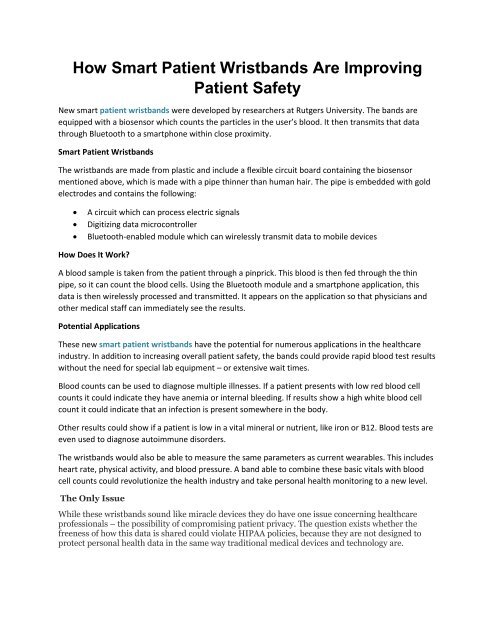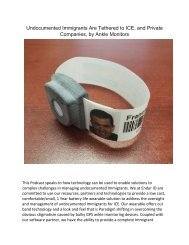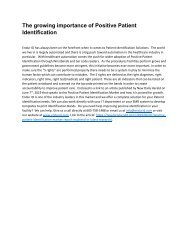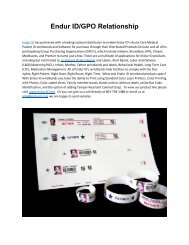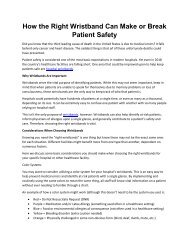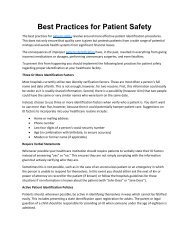How Smart Patient Wristbands Are Improving Patient Safety
New smart patient wristbands were developed by researchers at Rutgers University. The bands are equipped with a biosensor which counts the particles in the user’s blood. It then transmits that data through Bluetooth to a smartphone within close proximity. Visit: http://endurid.com
New smart patient wristbands were developed by researchers at Rutgers University. The bands are equipped with a biosensor which counts the particles in the user’s blood. It then transmits that data through Bluetooth to a smartphone within close proximity. Visit: http://endurid.com
Create successful ePaper yourself
Turn your PDF publications into a flip-book with our unique Google optimized e-Paper software.
<strong>How</strong> <strong>Smart</strong> <strong>Patient</strong> <strong>Wristbands</strong> <strong>Are</strong> <strong>Improving</strong><br />
<strong>Patient</strong> <strong>Safety</strong><br />
New smart patient wristbands were developed by researchers at Rutgers University. The bands are<br />
equipped with a biosensor which counts the particles in the user’s blood. It then transmits that data<br />
through Bluetooth to a smartphone within close proximity.<br />
<strong>Smart</strong> <strong>Patient</strong> <strong>Wristbands</strong><br />
The wristbands are made from plastic and include a flexible circuit board containing the biosensor<br />
mentioned above, which is made with a pipe thinner than human hair. The pipe is embedded with gold<br />
electrodes and contains the following:<br />
<br />
<br />
<br />
A circuit which can process electric signals<br />
Digitizing data microcontroller<br />
Bluetooth-enabled module which can wirelessly transmit data to mobile devices<br />
<strong>How</strong> Does It Work?<br />
A blood sample is taken from the patient through a pinprick. This blood is then fed through the thin<br />
pipe, so it can count the blood cells. Using the Bluetooth module and a smartphone application, this<br />
data is then wirelessly processed and transmitted. It appears on the application so that physicians and<br />
other medical staff can immediately see the results.<br />
Potential Applications<br />
These new smart patient wristbands have the potential for numerous applications in the healthcare<br />
industry. In addition to increasing overall patient safety, the bands could provide rapid blood test results<br />
without the need for special lab equipment – or extensive wait times.<br />
Blood counts can be used to diagnose multiple illnesses. If a patient presents with low red blood cell<br />
counts it could indicate they have anemia or internal bleeding. If results show a high white blood cell<br />
count it could indicate that an infection is present somewhere in the body.<br />
Other results could show if a patient is low in a vital mineral or nutrient, like iron or B12. Blood tests are<br />
even used to diagnose autoimmune disorders.<br />
The wristbands would also be able to measure the same parameters as current wearables. This includes<br />
heart rate, physical activity, and blood pressure. A band able to combine these basic vitals with blood<br />
cell counts could revolutionize the health industry and take personal health monitoring to a new level.<br />
The Only Issue<br />
While these wristbands sound like miracle devices they do have one issue concerning healthcare<br />
professionals – the possibility of compromising patient privacy. The question exists whether the<br />
freeness of how this data is shared could violate HIPAA policies, because they are not designed to<br />
protect personal health data in the same way traditional medical devices and technology are.
Built-in security measures, were they to be included in the devices, can be bypassed easily. This has<br />
been shown with devices like the FitBit. With a moderate amount of technological knowledge and a<br />
little motivation, the information contained on these devices can be hacked.<br />
When that information is leaked, not only are current HIPAA policies breached but so is the risk of<br />
patient safety. The ways people can abuse personal health information are far-reaching, and this<br />
seemingly harmless data can even assist in professional credit fraud or identity theft.<br />
If this issue were to be fixed, however, these devices would be the answer to easier monitoring<br />
medical professionals have been seeking.


